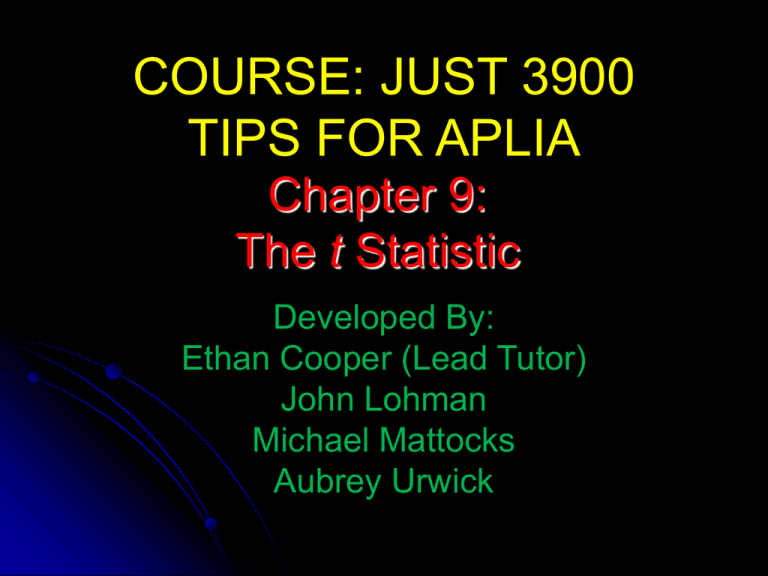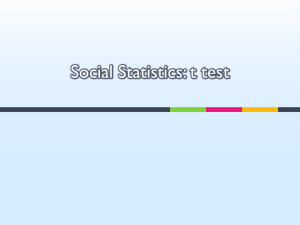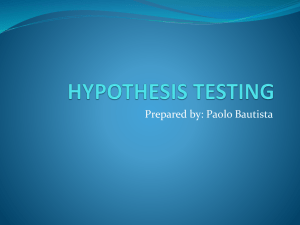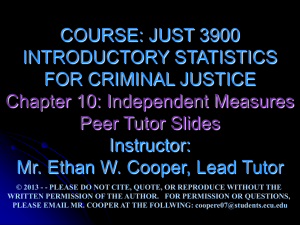Document
advertisement

COURSE: JUST 3900 TIPS FOR APLIA Chapter 9: The t Statistic Developed By: Ethan Cooper (Lead Tutor) John Lohman Michael Mattocks Aubrey Urwick Key Terms: Don’t Forget Notecards Hypothesis Test (p. 233) Null Hypothesis (p. 236) Alternative Hypothesis (p. 236) Alpha Level (level of significance) (pp. 238 & 245) Critical Region (p. 238) Estimated Standard Error (p. 286) t statistic (p. 286) Degrees of Freedom (p. 287) t distribution (p. 287) Confidence Interval (p. 300) Directional (one-tailed) Hypothesis Test (p. 304) Formulas Estimated Standard Error: 𝑠𝑀 = 𝑠 𝑛 = t-Score Formula: 𝑡 = 𝑀−𝜇 𝑠𝑀 estimated Cohen’s d: 𝑚𝑒𝑎𝑛 𝑑𝑖𝑓𝑓𝑒𝑟𝑒𝑛𝑐𝑒 𝑠𝑡𝑎𝑛𝑑𝑎𝑟𝑑 𝑑𝑒𝑣𝑖𝑎𝑡𝑖𝑜𝑛 𝑀𝑡𝑟𝑒𝑎𝑡𝑚𝑒𝑛𝑡 − 𝜇𝑛𝑜 𝑡𝑟𝑒𝑎𝑡𝑚𝑒𝑛𝑡 𝑠 r 2: 𝑟2 = 𝑡2 𝑡 2 +𝑑𝑓 𝑑𝑓 = 𝑛 − 1 𝑠2 𝑛 = = 𝑠2 𝑛 You May Need These Formulas 𝑋 𝑛 Sample Mean: 𝑀 = Definitional Formula for SS: 𝑆𝑆 = 𝑋−𝑀 𝑋2 Computational Formula for SS: 𝑆𝑆 = Sample Variance: 𝑠2 = 2 − 𝑆𝑆 𝑛−1 Sample Standard Deviation: 𝑠 = 𝑠2 = 𝑆𝑆 𝑛−1 𝑋 2 𝑛 When to Use the t Statistic Question 1: Under what circumstances is a t statistic used instead of a z-score for a hypothesis test? When to Use the t Statistic Question 1 Answer: A t statistic is used instead of a z-score when the population standard deviation (σ) and variance (σ2) are not known. Estimated Standard Error Question 2: A sample of n = 9 scores has a SS = 288. a) b) Compute the variance for the sample. Compute the estimated standard error for the sample mean. Estimated Standard Error Question 2 Answer: a) b) 𝑠2 = 𝑆𝑆 𝑛−1 = 𝑠𝑀 = 𝑠2 𝑛 = 288 9−1 36 9 = 288 8 = 36 = 4=2 Possible Outcomes of a Hypothesis Test Question 3: A researcher reports a t statistic with df = 20. How many individuals participated in the study? Possible Outcomes of a Hypothesis Test Question 3 Answer: 𝑑𝑓 = 𝑛 − 1 20 = 𝑛 − 1 𝑛 = 21 Two-Tailed Hypothesis Test Using the t Statistic Question 4: A sample of n = 4 is selected from a population with a mean of µ = 40. A treatment is administered to the individuals in the sample and, after treatment, the sample has a mean of M = 44 and a variance of s2 = 16. Is this sample sufficient to conclude that the treatment has an effect? (Use a two-tailed test with α = 0.05) If all other factors are held constant and the sample size is increased to n = 16, is the sample sufficient to conclude that the treatment has a significant effect? (Use a two-tailed test with α = 0.05) Two-Tailed Hypothesis Test Using the t Statistic Question 4 Answer: Step 1: State hypotheses H0: Treatment has no effect. (µ = 40) H1: Treatment has an effect. (µ ≠ 40) Step 2: Set Criteria for Decision (α = 0.05) Critical t = ± 3.182 Two-Tailed Hypothesis Test Using the t Statistic df = 3 t Distribution with α = 0.05 Critical region t = - 3.182 Critical region t = + 3.182 Two-Tailed Hypothesis Test Using the t Statistic Question 4 Answer: Step 3: Compute sample statistic 𝑠2 𝑛 = 𝑀−𝜇 𝑠𝑀 = a) 𝑠𝑀 = b) 𝑡= 16 4 = 44−40 2 4=2 = 4 2 = 2.00 Two-Tailed Hypothesis Test Using the t Statistic df = 3 t Distribution with α = 0.05 Critical region t = - 3.182 t = 2.00 Critical region t = + 3.182 Two-Tailed Hypothesis Test Using the t Statistic Question 4 Answer Step 4: Make a decision For a Two-tailed Test: If -3.182 < tsample < 3.182, fail to reject H0 If tsample ≤ -3.182 or tsample ≥ 3.182, reject H0 tsample (2.00) < tcritical (3.182) Thus, we fail to reject the null and cannot conclude that the treatment has an effect. Two-Tailed Hypothesis Test Using the t Statistic Question 4 Answer: Step 1: State hypotheses H0: Treatment has no effect. (µ = 40) H1: Treatment has an effect. (µ ≠ 40) Step 2: Set Criteria for Decision (α = 0.05) Critical t = ± 2.131 Two-Tailed Hypothesis Test Using the t Statistic df = 15 t Distribution with α = 0.05 Critical region t = - 2.131 Critical region t = + 2.131 Two-Tailed Hypothesis Test Using the t Statistic Question 4 Answer: Step 3: Compute sample statistic a) 𝑠𝑀 = b) 𝑡= 16 16 𝑀−𝜇 𝑠𝑀 = = 1=1 44−40 1 = 4 1 = 4.00 Two-Tailed Hypothesis Test Using the t Statistic df = 15 t Distribution with α = 0.05 Critical region t = - 2.131 Critical region t = + 2.131 t = 4.00 Two-Tailed Hypothesis Test Using the t Statistic Question 4 Answer: Step 4: Make a decision For a Two-tailed Test: If -2.131 < tsample < 2.131, fail to reject H0 If tsample ≤ -2.131 or tsample ≥ 2.131, reject H0 tsample (4.00) < tcritical (2.131) Thus, we reject the null and conclude that the treatment has an effect. One-Tailed Hypothesis Test Using the t Statistic Question 5: Dr. Johnson is conducting research on a new supplement that claims to improve physical performance. The average 40 yard dash time for college football players is µ = 4.65 seconds. A sample of n = 25 players is chosen to test this supplement. Each player is given the supplement, and, 1 hour later, 40 yard dash time is measured for each player. The average time for this sample is M = 4.57 seconds with SS = 3.6. Dr. Anderson would like to use a hypothesis test with α = 0.05 to evaluate the effectiveness of the supplement. Use a one-tailed test to determine whether the supplement produces a significant decrease in 40 yard dash times. One-Tailed Hypothesis Test Using the t Statistic Question 5 Answer: Step 1: State hypotheses H0: Supplement does not decrease 40 yard dash times. (µ ≥ 4.65) H1: Supplement does decrease 40 yard dash times. (µ < 4.65) Step 2: Set Criteria for Decision (α = 0.05) Critical t: -1.711 One-Tailed Hypothesis Test Using the t Statistic df = 24 t Distribution with α = 0.05 Critical region Because this is a one-tailed test‚ there is only one critical region. t = -1.711 One-Tailed Hypothesis Test Using the t Statistic Question 5 Answer: Step 3: Compute sample statistic a) 𝑠2 = b) 𝑠𝑀 = c) 𝑡= 𝑆𝑆 𝑛−1 = 0.15 25 𝑀−𝜇 𝑠𝑀 3.6 25−1 = = = 3.6 24 = 0.15 0.006 = 0.08 4.57−4.65 0.08 = −0.08 0.08 = −1.00 One-Tailed Hypothesis Test Using the t Statistic df = 24 t Distribution with α = 0.05 Critical region Because this is a one-tailed test‚ there is only one critical region. t = -1.711 t = -1.00 One-tailed Hypothesis Test Question 5 Answer: Step 4: Make a decision For a One-tailed Test: If tsample > -1.711, fail to reject H0 If tsample ≤ -1.711, reject H0 tsample (-1.00) > tcritical (-1.711) Thus, we fail to reject the null and cannot conclude that the supplement decreases 40 yard dash times. Estimated Cohen’s d and r2 Question 6: A sample of n = 16 is selected from a population with a mean of µ = 80. A treatment is administered to the sample and, after treatment, the sample is found to be M = 86 with a standard deviation of s = 8. a) b) Find estimated Cohen’s d. Find r2. Estimated Cohen’s d and r2 Question 6a Answer: 𝑚𝑒𝑎𝑛 𝑑𝑖𝑓𝑓𝑒𝑟𝑒𝑛𝑐𝑒 𝑠𝑡𝑎𝑛𝑑𝑎𝑟𝑑 𝑑𝑒𝑣𝑖𝑎𝑡𝑖𝑜𝑛 estimated Cohen’s d: d= This is a medium to large effect. 86−80 8 = 𝑀𝑡𝑟𝑒𝑎𝑡𝑚𝑒𝑛𝑡 − 𝜇𝑛𝑜 𝑡𝑟𝑒𝑎𝑡𝑚𝑒𝑛𝑡 𝑠 6 8 = = 0.75 Remember: This week in Aplia, if d falls between 0.2 and 0.5, it is a small to medium effect. If d falls between 0.5 and 0.8, it is a medium to large effect. Estimated Cohen’s d and r2 Question 6b Answer: 𝑟2 = 𝑡2 𝑡 2 +𝑑𝑓 𝑑𝑓 = 𝑛 − 1 = 16 − 1 = 15 Find t and df. 𝑠𝑀 = 𝑡= 𝑟 2 = 𝑡 2 +𝑑𝑓 = 32+15 = 9+15 = 24 = 0.375 = 37.5% 𝑠 𝑛 = 𝑀−𝜇 𝑠𝑀 = 𝑡2 8 16 8 = 4 = 2.00 86−80 2 32 = 6 2 = 3.00 9 9 This is a large effect. Confidence Intervals Question 7: A sample of n = 16 is selected from a population with a mean of µ = 80. A treatment is administered to the sample and, after treatment, the sample is found to be M = 86 with a standard deviation of s = 8. Find the 95% confidence interval for the population mean after treatment. Confidence Intervals Question 7 Answer: Step #1: Look up the corresponding t values in the t distribution table for scores that crop the middle 95% of the distribution. This means that you need to have 2.5% in each tail. Calculate the degrees of freedom for t : df = n – 1 = 16 -1 = 15 Now look up the values of t with 15 df for a 1 tail test at 0.025 or a 2 tail test at 0.05: t = +/- 2.131 Confidence Intervals df = 15 Middle 95% of t distribution 2.5% in the lower tail t = - 2.131 2.5% in the upper tail t = + 2.131 Confidence Intervals Step #2: Calculate the bounded values of the interval. To do this, you must use M and sM as obtained from the sample data and plug these values into the estimation formula: μ = M ± t*sM μ = M ± t*sM = 86 +/- (2.131)*(2.00) μlower = M - t*sM = 86 - (2.131)*(2.00) = 81.738 μupper = M + t*sM = 86 + (2.131)*(2.00) = 90.262 Confidence Intervals Step #3: Summarize the findings After treatment our population mean should fall between μ = 81.738 and μ = 90.262. We are 95% confident that the true population mean is located within this interval. Value for lower boundary of 95% confidence interval Value for upper boundary of 95% confidence interval Values that fall in the middle of the 95% CI 81.738 M = 86 90.262 Frequently Asked Questions FAQs Will we be asked to remember formulas and concepts from past chapters? Like all math classes, statistics is a course that builds on itself as the semester progresses. Therefore, it is entirely possible that either Aplia, the test, or both will expect you to remember formulas and concepts from previous chapters. There is an example on the next slide. Frequently Asked Questions FAQs The following sample was obtained from a population with unknown parameters. Scores: 6, 12, 0, 3, 4 Compute the sample mean and standard deviation. Compute the estimated standard error for M. Frequently Asked Questions FAQs 𝑋 𝑛 = 6+12+0+3+4 5 Sample Mean: 𝑀 = Definitional Formula for SS: 𝑆𝑆 = = 25 5 =5 𝑋−𝑀 2 X X-M (X – M)2 6 6–5=1 (1)2 = 1 12 12 – 5 = 7 (7)2 = 49 0 0 – 5 = -5 (-5)2 = 25 3 3 – 5 = -2 (-2)2 = 4 4 4 – 5 = -1 (-1)2 = 1 SS = 80 Frequently Asked Questions FAQs 𝑆𝑆 𝑛−1 80 5−1 Sample Variance: 𝑠 2 = Sample Standard Deviation: 𝑠 = = Estimated Standard Error: 𝑠𝑀 = = 80 4 = 20 𝑠2 = 𝑠2 𝑛 = 20 5 20 = 4.47 = 2.00







